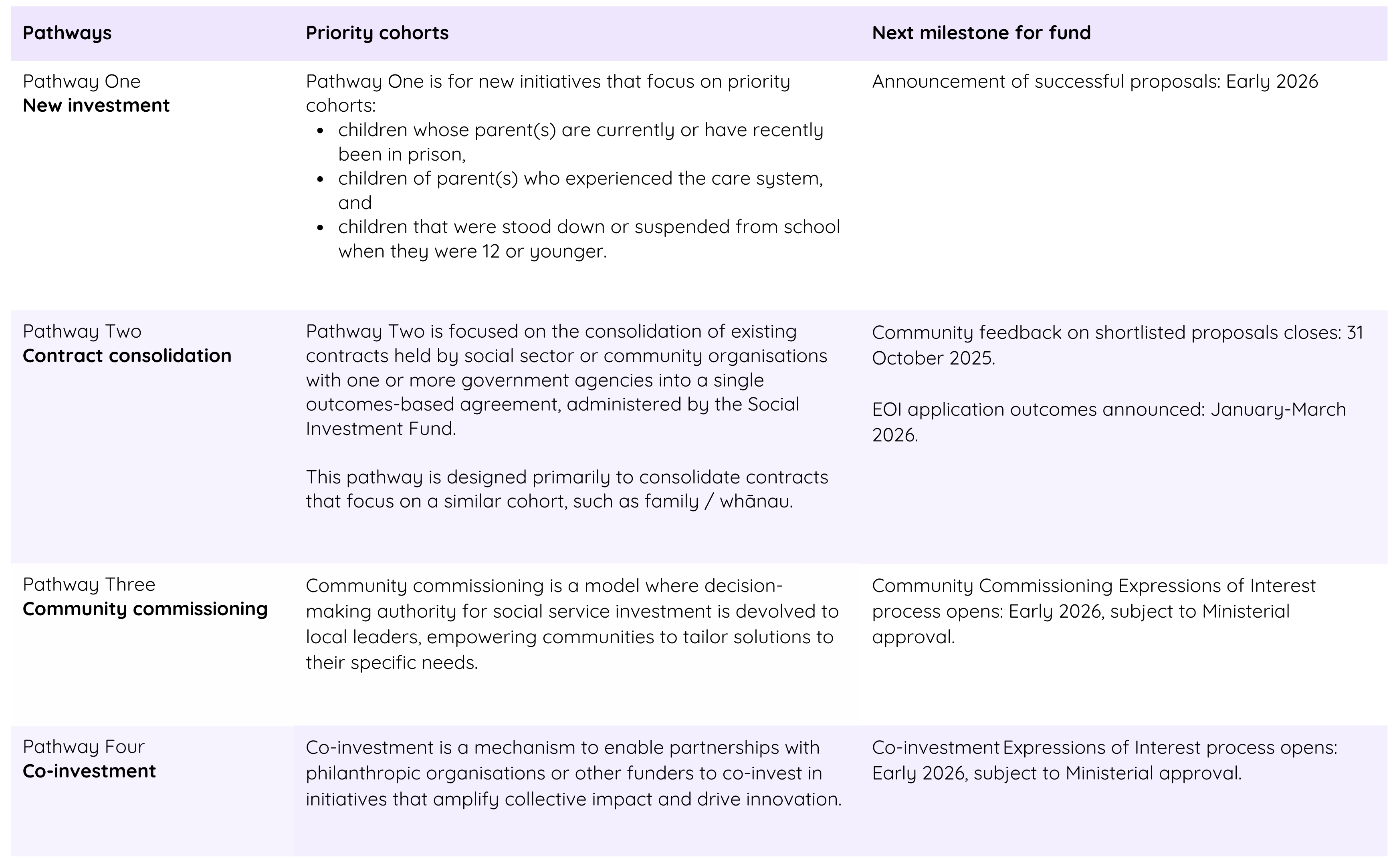The Social Investment Agency: What we know so far
With SIA’s second funding pathway EOI now closed, we unpack what the Social Investment Agency is, what it aims to do, and what these changes mean for providers in the social sector, kicking off our new series on SIA and outcomes-based funding.


With the Expression of Interest (EOI) period for the second SIA funding pathway now closed, it’s a good opportunity to get clarity on what the Social Investment Agency (SIA) is doing and what this means for providers. Over the past year, we’ve heard plenty of questions from the sector: What does the SIA actually do? How do the new funding pathways work? What are the ‘outcomes-based funding standards’? And what does this mean for our mahi?
This post kicks off a series exploring the SIA and its role in the social impact measurement space. We answer some key questions that providers have been asking, unpacking what these changes may mean on the ground. Drawing on our technical engagement with SIA and expertise in the field, this series reflects our understanding and interpretation of their approach and is not produced or endorsed by SIA.
Q: What do the SIA do? How is it relevant to my mahi?
The Social Investment Agency (SIA) is a central government agency focused on shifting how social services are funded and measured. It was created in response to long-standing concerns that the system was too focused on short-term contracts, siloed agencies, and counting outputs (like “how many people attended an event”) rather than outcomes (like “what changed for whānau”).
The Agency has gone through a few different versions over the past decade, reflecting shifts in government priorities. Most recently, in 2024, the SIA was given a mandate to:
- Set standards for outcomes-based funding.
- Build the data and evidence infrastructure to support decision-making.
- Manage a new Social Investment Fund announced in Budget 2025.
This signals a broader shift in intent for how funding should work across government. Based on the SIA’s stated approach, some of the shifts you may see include:
- More emphasis on evidence and results – being able to show the difference your mahi makes, not just the activities delivered.
- Changes to contracts – over time, more consolidated, longer, and outcomes-focused contracts, rather than lots of small, short-term ones.
- Direct and indirect influence – SIA both invests in some initiatives itself (through the Social Investment Fund) and sets standards for other agencies to follow.
In practice, that means the way you tell your story — who you serve, how you know it works, and what impact it has — is becoming more important.
Q: What is ImpactLab’s relationship with the SIA?
We’re not the SIA, but we work alongside them. As a provider of social impact measurement supporting a network of 200+ NGOs, we’ve been in ongoing dialogue with the SIA to understand their priorities, approaches, and emerging thinking. The SIA is one of many funders we engage with, to understand their priorities and approaches.
ImpactLab acts as an independent, neutral intermediary within the social services ecosystem. We aren’t funders ourselves. Instead, we work closely with both service providers and funders to help decision-makers use data and evidence effectively — ensuring that funding and service delivery are informed by clear insights and real-world impact.
.png)
Q: There is talk about how the SIA is going to influence how other government agencies tender. Is this true?
Based on what the SIA has shared so far, part of their role is to influence how funding and contracting happens across government. This could mean future tenders across other agencies put more emphasis on evidence and data, consolidate their contracts, or engage more collaboratively with other agencies – though we haven’t seen any formal guidance yet.
Q. So what is the Social Investment Fund?
The SIA describes the Social Investment Fund as a new government fund designed to support initiatives that can clearly show the difference they make for communities, using data and evidence to guide where investment goes.
The Fund is being rolled out through a series of pathways, each focused on a specific priority area. For each pathway, providers are invited to submit an Expression of Interest (EOI), with selected organisations then supported through a more detailed design and investment process.
It is designed to demonstrate social investment in practice, with robust outcome-based agreements centred on a clear theory of change and evaluability built-in from the start. The aim is for government data and insights to be provided to service delivery organisations to help them understand their reach and impact, adopting a relational approach that focuses on learning and outcomes.
Q. What funding rounds are open or upcoming? Would my organisation be eligible?
Below is a summary of the SIA funding pathways that have been released so far. This information reflects what’s publicly available as of the 22 October 2025. As the SIA continues to roll out the Fund, more pathways may be added or updated — so it’s worth keeping an eye on their website for the latest details.

Coming up soon:
We’ll be taking a closer look at what’s involved in the application process — unpacking the requirements, what SIA is looking for, and how you can prepare.
Photo by Leroy de Thierry on Unsplash
With the Expression of Interest (EOI) period for the second SIA funding pathway now closed, it’s a good opportunity to get clarity on what the Social Investment Agency (SIA) is doing and what this means for providers. Over the past year, we’ve heard plenty of questions from the sector: What does the SIA actually do? How do the new funding pathways work? What are the ‘outcomes-based funding standards’? And what does this mean for our mahi?
This post kicks off a series exploring the SIA and its role in the social impact measurement space. We answer some key questions that providers have been asking, unpacking what these changes may mean on the ground. Drawing on our technical engagement with SIA and expertise in the field, this series reflects our understanding and interpretation of their approach and is not produced or endorsed by SIA.
Q: What do the SIA do? How is it relevant to my mahi?
The Social Investment Agency (SIA) is a central government agency focused on shifting how social services are funded and measured. It was created in response to long-standing concerns that the system was too focused on short-term contracts, siloed agencies, and counting outputs (like “how many people attended an event”) rather than outcomes (like “what changed for whānau”).
The Agency has gone through a few different versions over the past decade, reflecting shifts in government priorities. Most recently, in 2024, the SIA was given a mandate to:
- Set standards for outcomes-based funding.
- Build the data and evidence infrastructure to support decision-making.
- Manage a new Social Investment Fund announced in Budget 2025.
This signals a broader shift in intent for how funding should work across government. Based on the SIA’s stated approach, some of the shifts you may see include:
- More emphasis on evidence and results – being able to show the difference your mahi makes, not just the activities delivered.
- Changes to contracts – over time, more consolidated, longer, and outcomes-focused contracts, rather than lots of small, short-term ones.
- Direct and indirect influence – SIA both invests in some initiatives itself (through the Social Investment Fund) and sets standards for other agencies to follow.
In practice, that means the way you tell your story — who you serve, how you know it works, and what impact it has — is becoming more important.
Q: What is ImpactLab’s relationship with the SIA?
We’re not the SIA, but we work alongside them. As a provider of social impact measurement supporting a network of 200+ NGOs, we’ve been in ongoing dialogue with the SIA to understand their priorities, approaches, and emerging thinking. The SIA is one of many funders we engage with, to understand their priorities and approaches.
ImpactLab acts as an independent, neutral intermediary within the social services ecosystem. We aren’t funders ourselves. Instead, we work closely with both service providers and funders to help decision-makers use data and evidence effectively — ensuring that funding and service delivery are informed by clear insights and real-world impact.
.png)
Q: There is talk about how the SIA is going to influence how other government agencies tender. Is this true?
Based on what the SIA has shared so far, part of their role is to influence how funding and contracting happens across government. This could mean future tenders across other agencies put more emphasis on evidence and data, consolidate their contracts, or engage more collaboratively with other agencies – though we haven’t seen any formal guidance yet.
Q. So what is the Social Investment Fund?
The SIA describes the Social Investment Fund as a new government fund designed to support initiatives that can clearly show the difference they make for communities, using data and evidence to guide where investment goes.
The Fund is being rolled out through a series of pathways, each focused on a specific priority area. For each pathway, providers are invited to submit an Expression of Interest (EOI), with selected organisations then supported through a more detailed design and investment process.
It is designed to demonstrate social investment in practice, with robust outcome-based agreements centred on a clear theory of change and evaluability built-in from the start. The aim is for government data and insights to be provided to service delivery organisations to help them understand their reach and impact, adopting a relational approach that focuses on learning and outcomes.
Q. What funding rounds are open or upcoming? Would my organisation be eligible?
Below is a summary of the SIA funding pathways that have been released so far. This information reflects what’s publicly available as of the 22 October 2025. As the SIA continues to roll out the Fund, more pathways may be added or updated — so it’s worth keeping an eye on their website for the latest details.

Coming up soon:
We’ll be taking a closer look at what’s involved in the application process — unpacking the requirements, what SIA is looking for, and how you can prepare.
Photo by Leroy de Thierry on Unsplash

The Social Investment Agency: What we know so far
With SIA’s second funding pathway EOI now closed, we unpack what the Social Investment Agency is, what it aims to do, and what these changes mean for providers in the social sector, kicking off our new series on SIA and outcomes-based funding.

Part 2- Understanding the Intervention Logic
Part 2 of this series, unpacks the Intervention Logic, outlining how it differs from a Theory of Change and the role it plays in mapping programmes, evaluating outcomes, and supporting clear communication with stakeholders.

Part 1- Understanding the Theory of Change
In the first article in this two-part series we introduce the Theory of Change, a flexible framework that maps how services create impact. It explains its purpose, benefits, and why it’s a powerful tool for guiding, testing, and communicating change.

Why measuring social impact matters to funders and housing providers
Measuring social impact in housing helps funders and providers target services to residents’ real needs, improve wellbeing, reduce costs, and guide smarter decisions across the housing lifecycle with stronger outcomes for people and communities.
Get in touch
We help impact organisations know, show and grow their social impact. Let’s work together to do good, better!



